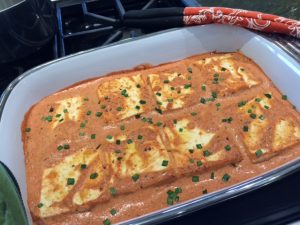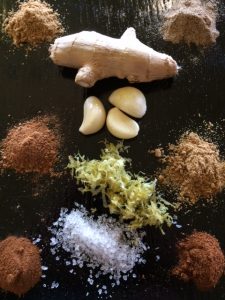I love tandoori and even without the traditional oven, I can concoct a spice mixture that passes for the real thing. Husband and I ate tandoori for days recently while I experimented — with a little help from Ka’iulani Spices.
This Honolulu-based spice-blending company, owned by my friend Kai Cowell, will release a new cookbook in fall and, in consulting on that project, I became familiar with the flavor profiles of each of her six products. I often substitute the rub/seasoning mixtures for other ingredients. For example, I make a faux Herbes de Provence by using her Lani’s Herb Garden and adding just a pinch of culinary lavender from Maui Kula Lavender.
I took this blend-to-taste approach with tandoori recently.
First, let’s talk Tandoori: This beloved Indian dish isn’t a specific recipe, it’s a cooking technique that takes its name from the tandoor, a jar-shaped masonry oven (squared-off metal version are used in contemporary kitchens). A wood, charcoal or gas fire burns white-hot at the bottom of the oven and marinated meats, flatbreads, cakes of grain and/or vegetables, even stuffed pastries, are slapped onto the curving walls. The food peels off with a toothsome seared exterior, moist and tender within.
In the U.S., the term tandoori has come to be identified most closely with meats marinated in a blend of yogurt, fresh citrus, ginger and a generous handful of spices then tinted — why, I do not know???— with red food coloring.
Diversion No. 2: Curry, which comes into this particular version of tandoori sauce. Curry is not a single spice, it’s a mixture of spices, herbs, aromatics, chilies, salt, even sugar. The contents of curry blends depend on regional preferences, available ingredients and the palate of the cook. Curries can be fiery hot or mellow and sweetish. Curry mixtures can be used in dishes that we might not consider curries, such as this one.
I was paging through Diana Shaw’s excellent “Almost Vegetarian” (subtitled “A Primer for Cooks Who Are Eating Vegetarian Most of the Time, Chicken and Fish Some of the time & Altogether Well All of the Time”) and saw a tandoori recipe that sent me dancing to the spice cupboard. I noticed that many of the spices called for in her recipe were present in one of my favorite ingredients, Ka’iulani Spices’ Exotic Curry All-Purpose Rub and Seasoning. So I decided to mix and match, using a couple of tablespoons of the curry and pumping up the flavors I like, including cumin and coriander, and warm spices such as cinnamon and cardamom.
As a food writer, I keep a very full and varied spice cabinet, but most people have no reason to do so; spices are expensive and lose their pungency rapidly. That’s why Kai’s blends can be so helpful; they replace a lot of little bottles and they have multiple uses. I tried this recipe out on Kai and she loved the dish but rolled her eyes at the longish ingredient list. I challenged her to make a tandoori mixture using mostly her spice mixtures. Check her Facebook page later this week to see how she did.
Be clear on this: Though I have worked with Kai, I’m not on her payroll and I’m not wedded to the idea of using only her mixtures. If you want to keep a cubpoard full of asafoetida and cassia bark, and if you’ll use them in a timely manner, by all means play and enjoy. If you, like so many people, are too busy, too timid, too cash-strapped to buy out the spice section, consider alternatives such as Kai offers.
But I, as usual, digress. Bottom line on tandoori: Start with garlic, ginger, lemon and cilantro, as below, pureed in blender or food processor; add a spice mixture that pleases you; end with yogurt and food coloring.
I made this with skinless boneless chicken breasts stovetop “grilled” in my beloved black cast iron pan with ridges that “mark” the meat and keep it from boiling in its juices. But I was very pleased with how much we liked the tofu “steak” version: Not pretty, I admit, but really good.
One caution: The chilies or other heated ingredients in this sauce grow more intense over time. You can make the marinade ahead by a day, but by two or three days, depending on who much cayenne or Ka’iulani Pele’s Fire or other hot ingredient you used, you may be breathing fire by Day 3!

Tandoori Tofu doesn’t look like much but it has a BIG flavor, healthful, too. It makes much of hot naan bread, basmati brown rice or other relatively bland accompaniments.
Tandoori-Type Pressed Tofu (or Chicken)
2 cloves garlic (or more to taste)
1 (2-inch) piece peeled fresh ginger
Juice and zest of 1 lemon
¼ cup cilantro leaves, plucked from the stems
2 tablespoons Ka’iulani Exotic Curry
1 teaspoon EACH ground cumin and ground coriander
¼ teaspoon EACH cinnamon, nutmeg, cardamom
Pinch cayenne powder
1/2 teaspoon coarse kosher salt, to taste
1 cup plain yogurt (full-fat, low-fat or Greek)*
Red food coloring or ground achiote seed
1 pound pressed firm tofu, sliced into 8 “steaks” OR 2-4 skinless, boneless chicken breasts
In a food processor, pulse together garlic, ginger, lemon zest, cilantro leaves, curry powder, remaining spices and salt. Process in yogurt; add just enough food coloring to create a rosy glow, pulsing between additions.
Place half the yogurt marinade in the bottom of a flat baking dish; lay out the tofu slices (or chicken breasts**) on top and cover with more “sludge.” Cover and marinate 3 hours at room temperature or overnight in refrigerator. Turn periodically.
For tofu, broil marinated slices right in the baking dish, 4-6 minutes; no need to turn. Or, if you want to caramelize them a bit, place the slices on a rack over a parchment-lined baking sheet and broil.
For chicken, prepare wood or charcoal grill to white-hot heat or pre-heat stovetop grill pan. Grill chicken 4-6 minutes per side.
Serve over rice or with naan bread.
This recipe makes a generous amount of marinade, which can be spread about like gravy if it’s first heated through to avoid ingesting raw juices.
Makes 4 servings tofu or 2-4 servings chicken.
*About yogurt: I make yogurt “cheese” by draining the whey from plain yogurt (full-fat or low-fat) that contains live cultures. Cheese strainers, which are funnel- or barrel-shaped and made of plastic mesh, are available online (mine is ancient). Or make your own by lining a strainer or colander with several layers of damp cheesecloth. Balance the strainer over a bowl and dump a large tub of yogurt into the cheesecloth “nest.” Allow to drain all day or night. The whey that runs off is great for baking, or can be stirred into soups or stews. Yogurt cheese has a tart, slightly aged flavor and the texture of cream cheese. It can be used wherever cream cheese is called for and it can be flavored with minced herbs, grated lemon zest, pesto, chopped sun-dried tomatoes or whatever you wish.
**If using chicken breasts, flatten to create as even a texture as possible; place the chicken in a zippered plastic bag and whack with a meat mallet or the back side of a heavy cleaver.


